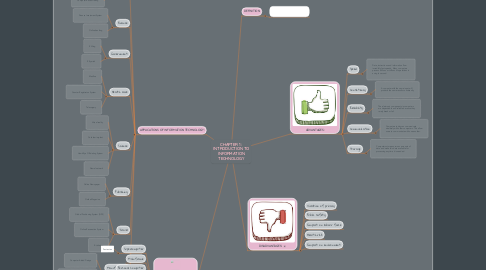
1. APPLICATIONS OF INFORMATION TECHNOLOGY:
1.1. Education
1.1.1. Learning Management System
1.1.2. Computer Based Trainng
1.2. Finance
1.2.1. Finance Investment System
1.2.2. Online banking
1.3. Government
1.3.1. E-filing
1.3.2. E-Syariah
1.4. Health care
1.4.1. Medline
1.4.2. Counter Registraton System
1.4.3. Telesurgery
1.5. Science
1.5.1. Virtual reality
1.5.2. Cochlear implant
1.5.3. Hawk Eye Officiating System
1.5.4. Neural network
1.6. Publishing
1.6.1. Online Newspaper
1.6.2. Online Magazine
1.7. Travel
1.7.1. Global Positioning System (GPS)
1.7.2. Online Reservation System
1.7.3. E-ticketing
1.8. Manufacturing
1.8.1. Computer-Aided Design
1.8.2. Computer Aided Manufacturing
2. CATEGORIES OF COMPUTERS
2.1. Supercomputer
2.1.1. Fastest an
2.2. Mainframe
2.3. Personal Computer
2.4. Mobile Computer and Device
2.5. Embedded Computers
3. DEFINITION
3.1. The use of computer, hardware and software to store, retrieve and manipulate information
4. ADVANTAGES:
4.1. Speed
4.1.1. Data, instructions and information flow incredibly fast speeds. Many computers process billions or trillions of operations in a single second.
4.2. Consistency
4.2.1. A computer with the same input will produce the same results consistently
4.3. Reliability
4.3.1. The electronic components in computers are dependable and reliable because they rarely break or fail
4.4. Communication
4.4.1. Computers today can communicate wirelessly with other computers. This allow users to communicate with one another.
4.5. Storage
4.5.1. Computers store enormous amounts of data and make this data available for processing anytime it is needed.
